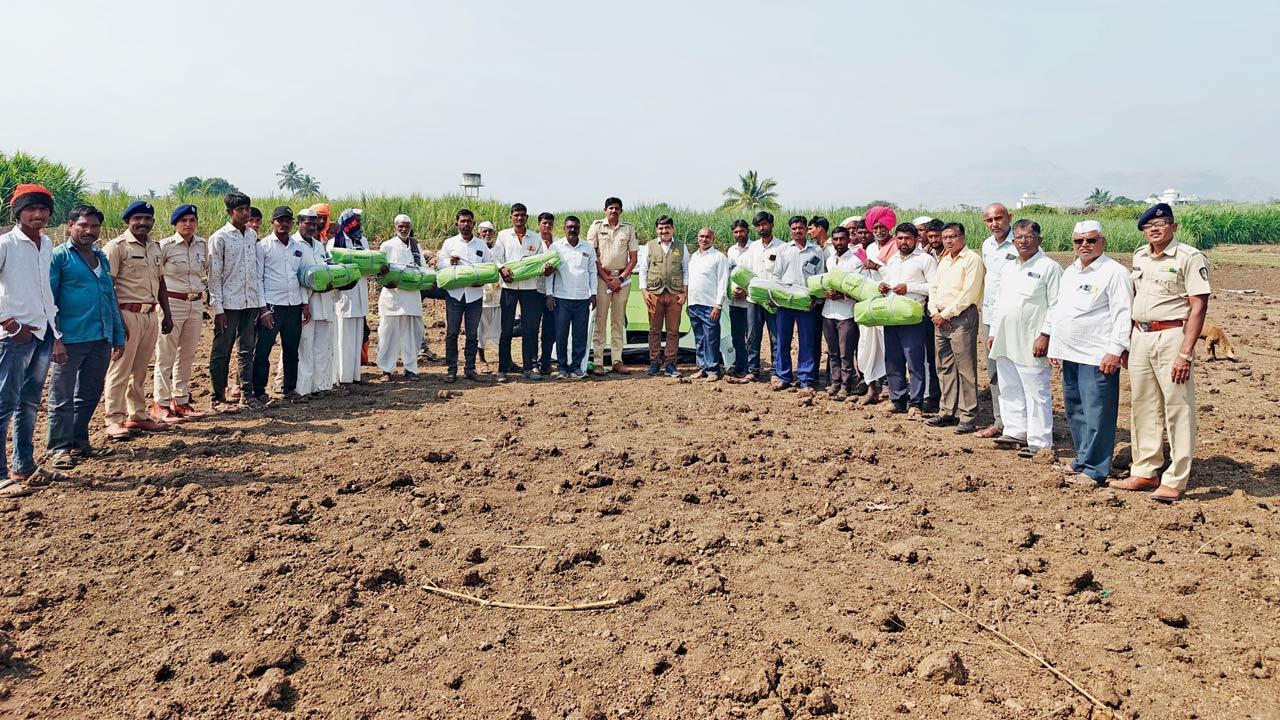Junnar Forest Division’s Deputy Conservator of Forest (DCF) Amol Satpute said, “We have made collars with engineering plastic spikes which a person working in the open will have to wear around his or her neck. The collars have been made for human protection in order to increase the safety of humans and to avoid human deaths.

Divisional Forest Officer (DFO) Amol Satpute (in jacket), along with department staff, distributed tents and other essentials to shepherds in the Junnar division
You must have seen spike collars around the necks of dogs and livestock in the Himalayas to protect them from predators like snow leopards and leopards. To prevent human deaths or injuries caused by human-leopard conflicts in Junnar, Pune district, the forest department is not only providing tents to shepherds but also planning to supply spike collars made of engineering plastic. These collars are to be tied around a person’s neck for protection.
ADVERTISEMENT
Junnar Forest Division’s Deputy Conservator of Forest (DCF) Amol Satpute said, “We have made collars with engineering plastic spikes which a person working in the open will have to wear around his or her neck. The collars have been made for human protection in order to increase the safety of humans and to avoid human deaths. The collars are still to be used in the field to know about its effectiveness. Junnar Forest Department has also distributed tents to the shepherds. Considering the increasing number of leopards in Junnar forest department jurisdiction, many measures like solar fences around houses, neck belts etc. are being implemented by the forest department to protect citizens from Human-leopard conflict incidents.”
 Spike collars that have been made of engineering plastic
Spike collars that have been made of engineering plastic
According to a tweet by the Maharashtra Forest Department on X, “For the protection of shepherds, the Junnar Forest Department has distributed tents to shepherds. Considering the increasing number of leopards in Junnar Forest Department’s jurisdiction, many measures like solar fences around houses, neck belts, etc., are being implemented by the forest department to protect citizens from leopards.”
Divisional Forest Officer (DFO) Amol Satpute, along with his forest department staff, distributed tents and other essentials to shepherds in the Junnar division a few days ago. Human-leopard conflict in the Junnar region has been a political issue, not just during the Lok Sabha elections but also in the recently held Maharashtra Assembly elections.
 Divisional Forest Officer Amol Satpute (fourth from left) and forest department staff distributed essentials in the Junnar division
Divisional Forest Officer Amol Satpute (fourth from left) and forest department staff distributed essentials in the Junnar division
During the elections, leaders contesting from the Assembly segment assured voters that, if elected, they would work closely with the forest department to address issues related to human-wildlife conflicts.
Reports indicate that, in the last two decades, 31 people have been killed, and more than 12,000 livestock have died due to human-leopard conflicts. In the Junnar region, where forest cover is sparse, leopards often use sugarcane fields for hiding and giving birth to cubs.
Data from the Junnar Forest Department shows that from 2020 to the present, 16 human deaths and 40 injuries have occurred due to human-leopard conflicts. Additionally, 11,442 livestock were injured, and 15,080 livestock deaths have been recorded in the same period.
The forest department has paid R2.8 crore in compensation to the families of the deceased and Rs 44.08 lakh to the families of the injured. Moreover, Rs 12.99 crore has been paid to families who lost or had their livestock injured in human-leopard conflicts.
ExpertSpeak
Wildlife conservationist and CEO of Wildlife Conservation Trust (WCT), Anish Andheria, said, “This has never been tried before. If you go by logic it should help by giving extra time to fight off the leopard, as the leopard’s instinct is to go for the neck of the victim. The collar will have to be wide enough to cover all the vulnerable parts of the back of the neck and the throat. The contraption will fail if even a small area is left open. One can only comment about the efficacy of this intervention after some pilots are run.”
Wildlife conservationist Kedar Gore from the Corbett Foundation said, “The efforts taken by the forest department to prevent leopard attacks on people are highly appreciated. Providing closed tents for nomadic tribes and shepherds to sleep at night might help in preventing or at least in reducing the attacks. The people may still be vulnerable when they venture out at night to attend nature’s call unless these tents have make-shift attached toilets. Providing spike collars made of engineering plastic which a person will be expected to tie around the neck while working in the field and at night seems impractical. The acceptance of such a collar by the local community may be challenging. The collars may hurt and be of discomfort to the person wearing them while sleeping or while at work. The best option would be to prevent anybody from sleeping in the open at night.”
16
No. of deaths reported in area since ’20
Rs 2.8cr
Total amount paid as compensation to kin of the deceased
Political issue

mid-day had earlier reported how MP from Shirur, Dr Amol Kolhe, has been advocating leopard population management by the Maharashtra Forest Department. He raised this issue in the Lok Sabha and also wrote to Bhupender Yadav, Union minister for environment, forest, and climate change. Dr Kolhe proposed population control measures for leopards in the Junnar Forest Division through targeted birth control initiatives.
On July 18, the Principal Chief Conservator of Forests (PCCF) Wildlife (Maharashtra) wrote to the Additional Director General (Wildlife) of the Ministry of Environment, Forest, and Climate Change (MOEF&CC). The DCF Junnar also submitted a proposal to the PCCF, highlighting the findings of a study conducted by the Wildlife Institute of India (WII) in collaboration with the Maharashtra Forest Department under the project titled Understanding Population Dynamics, Space Use, Movement, and Diet for Leopard Conflict Mitigation.
 Subscribe today by clicking the link and stay updated with the latest news!" Click here!
Subscribe today by clicking the link and stay updated with the latest news!" Click here!







